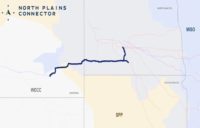The U.S. Energy Dept. has issued a new draft analysis of U.S. transmission needs, calling for an estimated three to four times more interstate power capacity by the 2030s to carry added wind and solar energy sources and prevent line congestion.
The report details problems such as blackouts and price spikes that occurred in Texas and other central U.S. states after a 2021 winter storm, but “prescribes no particular solutions to issues faced.”
Study models based on "moderate load but high clean energy assumptions" suggest need for an estimated 47,300 GW-miles of new transmission by 2035, 57% more than today, DOE says. The agency says it will issue a final report by summer and also is preparing a national transmission planning study with a detailed cost-benefit analysis of grid expansion.
In its review of transmission system data from 2011 to 2020, the study said regional entities spent between $0.19 and $5.29 per MWh of load on new transmission in the past decade, on average, adding over 34,000 circuit-miles of newly constructed or rebuilt lines rated above 100 kV.
Of these, over 22,000 circuit-miles were higher capacity lines rated at least 345 kV.
But said DOE, "Most of these investments were made in the first half of the decade, with transmission investment steadily declining since 2015."
Focus Is on Texas Connection
Researchers found that the "highest value" in new transmission would be to connect the independent Electric Reliability Council of Texas (ERCOT) system to the southwest region of the Western Interconnection, followed by a link with the Eastern Interconnection.
"The value of these interregional connections has been growing over the past five years of data considered," DOE said, but it added that "identifying the best nodal locations to make these connections requires additional engineering analysis which considers downstream system upgrades to support increased energy transfers."
The Federal Energy Regulatory Commission meanwhile is considering a mandate to require transfers of power among regional electric grids, particularly during extreme weather events.
in comments on the DOE study, ERCOT faulted the agency for not providing an adequate cost-benefit analysis to back construction of added lines into Texas. “Without such an analysis, ERCOT questions whether the study can establish an independent economic ‘need,’” it said.
But interregional transmission developers said the analysis supports their efforts.
“We are encouraged by the findings of the draft study which underscore the critical need for interregional transmission to deliver cost-effective generation, meet projected demand growth and usage shifts, and improve reliability and resilience, especially in the face of increasing extreme weather events, cybersecurity risks, and physical threats,” said Shashank Sane, a transmission executive at Chicago-based Invenergy LLC.
Invenergy, known mainly for its wind development, has proposed the $7-billion Green Belt Express to carry up to 5,000 MW of wind power from the Great Plains to users concentrated in the Great Lakes and mid-Atlantic regions. “The draft study rightly focuses on identifying market barriers to ... accelerate deployment of clean energy," he said.
About $15.5 billion is authorized for US power grid expansion and upgrade in the 2021 Infrastructure Investment and Jobs Act.






Post a comment to this article
Report Abusive Comment